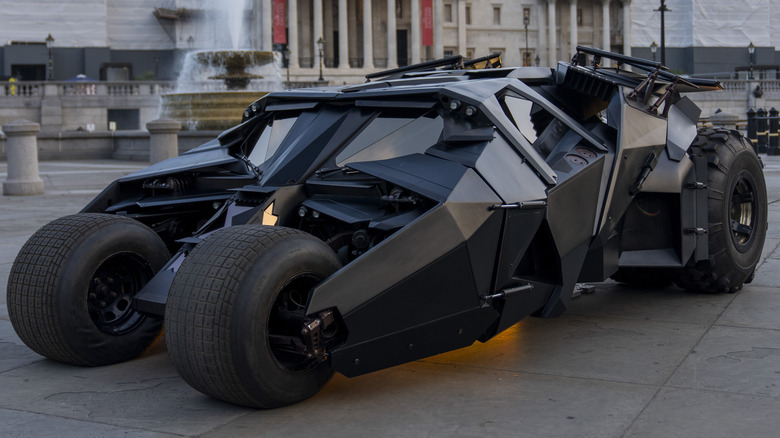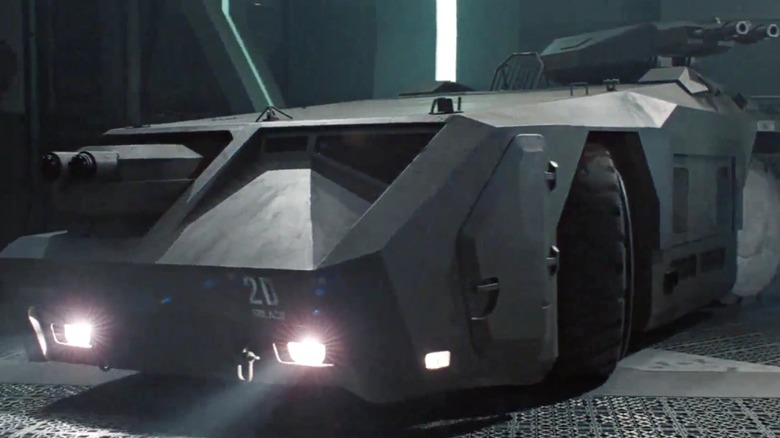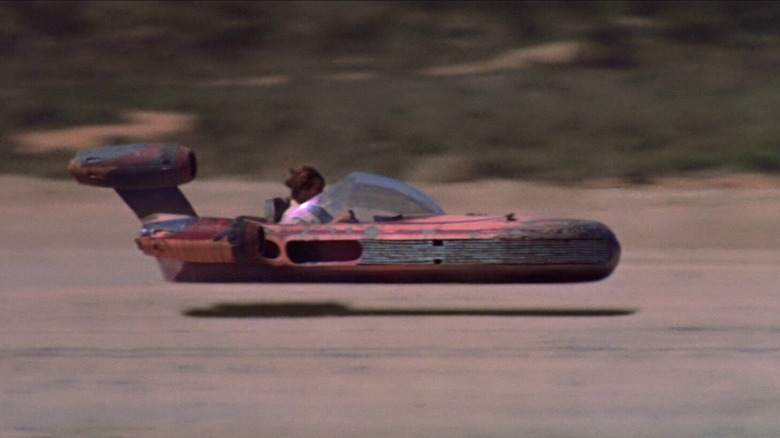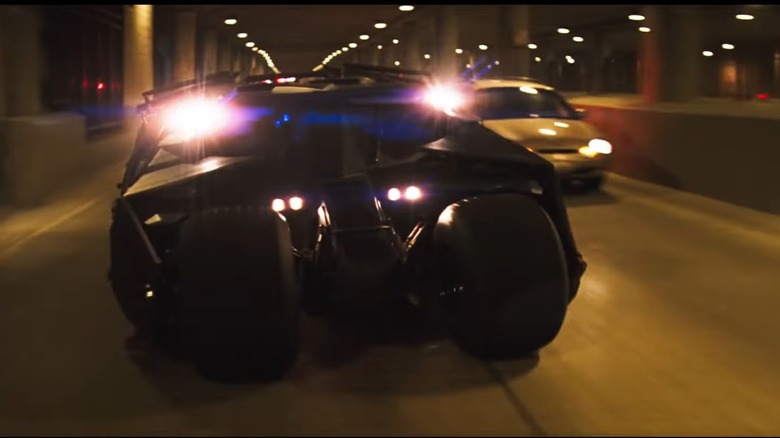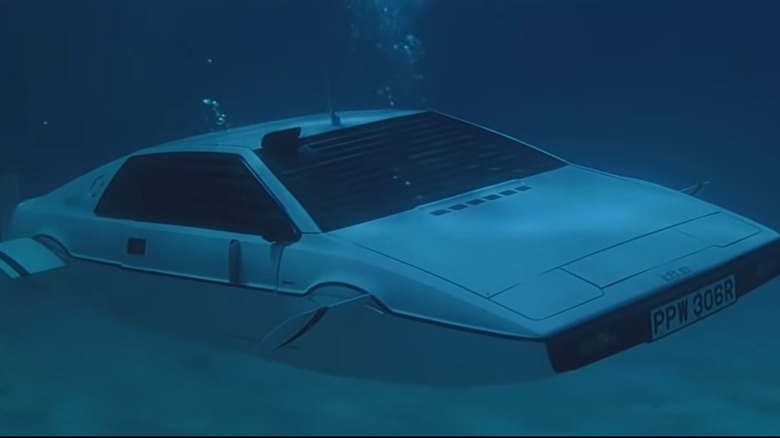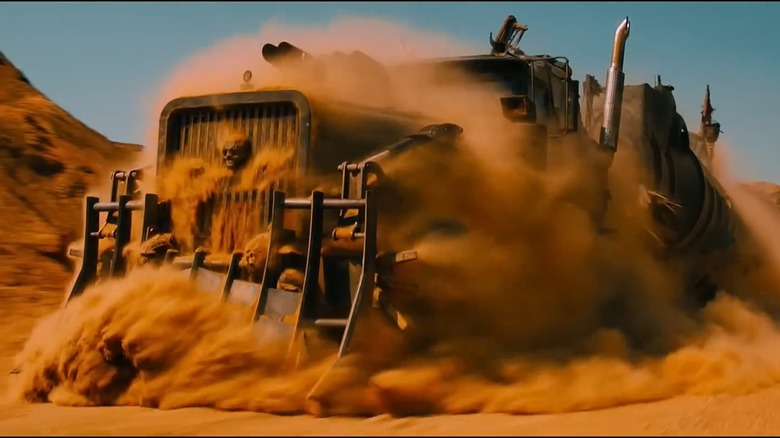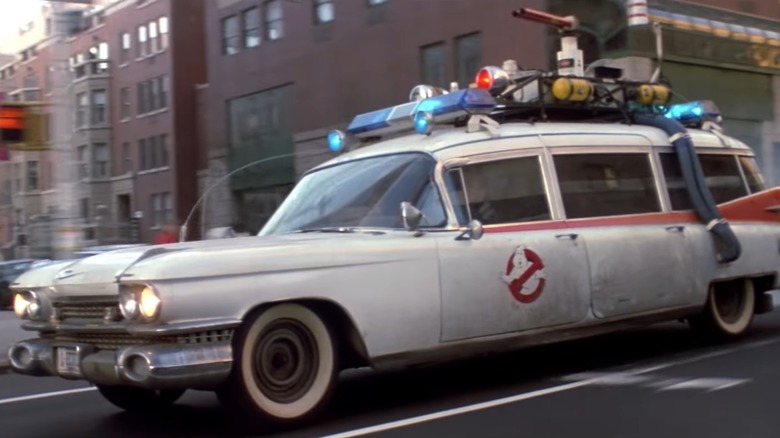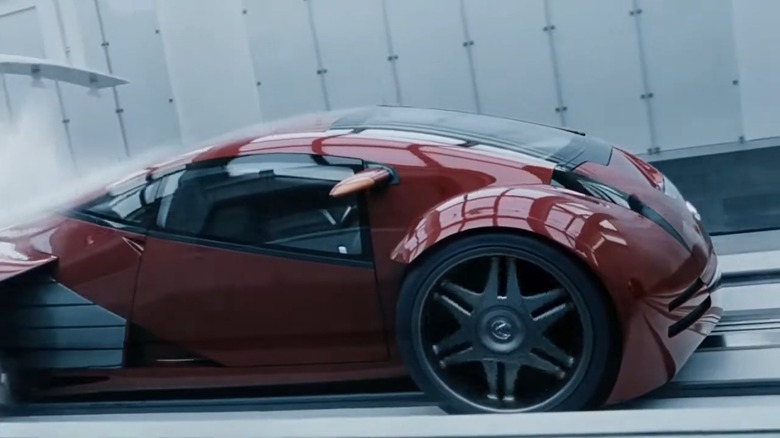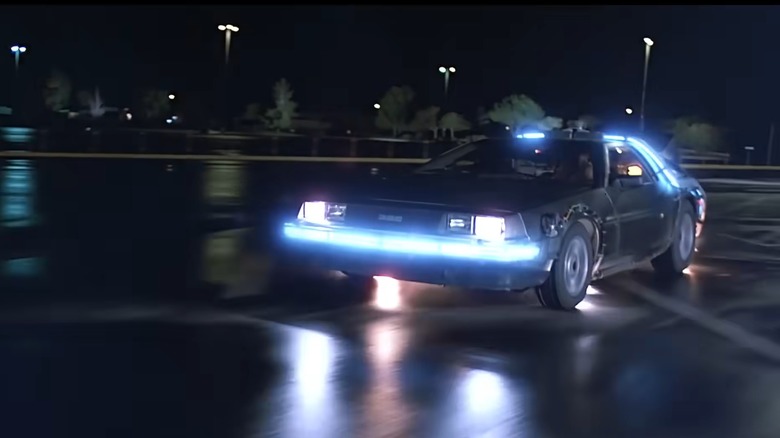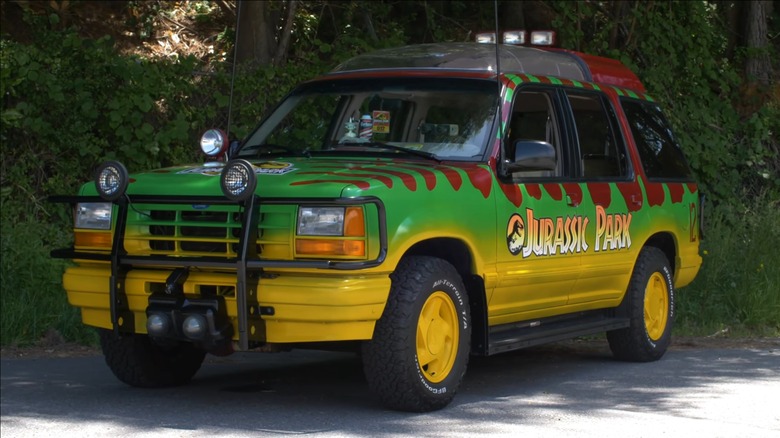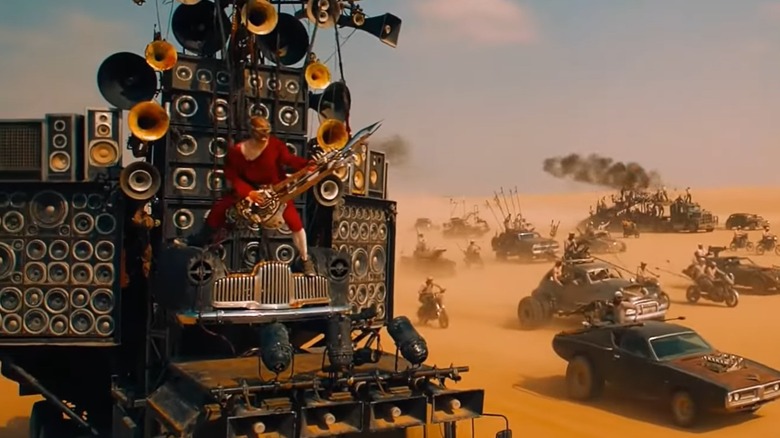Legendary Sci-Fi Vehicles: How They Were Really Built
Audiences love to live vicariously through the characters of their favorite stories. Occasionally, individual story beats are the cause, but other times it just comes down to the world itself. Case in point — sci-fi vehicles.
Since science fiction worlds aren't restricted to the limitations of real-world physics and energy generation, writers are free to go ham and a half on sci-fi vehicle concepts. Odds are you can find at least one design that speaks to you due to aesthetics or capabilities. Maybe it's Kaneda's iconic motorcycle from "Akira," or maybe it's the TARDIS from "Doctor Who" in all its blue glory. However, not everyone is aware of how much work goes into constructing these vehicles for the big and small screens — after all, not everything can be built out of computer-generated polygons like the Separatist Armored Assault Tank from "Star Wars: The Phantom Menace."
If a producer wants a sci-fi vehicle to have a tangible presence and a sense of realism, they have to use a live, physical model. For larger vehicles or when cars and spaceships perform feats of fantastical daring, a miniature is often required, but when the vehicle has to interact with actors or live sets, it is usually built to scale using available parts. Here are 10 iconic sci-fi vehicles and how they were made.
Aliens' M577 Armored Personnel Carrier
The earlier "Alien" movies are a masterclass of set and prop design, thanks in no small part to the legendary H.R. Giger and his work conceptualizing the titular aliens. Production value is through the roof in these films, but set designers cut corners wherever possible. For instance, tools hanging from the medical bay ceiling in "Aliens" are semi-transformed Shockwave Transformers toys. The film crew used a similar recycling trick for the movie's armored transport.
In "Aliens," the M577 Armored Personnel Carrier (APC) is a lightweight, low profile troop transport that is designed to safely ferry United States Colonial Marine Corps soldiers from a dropship to their destination. While the APC has enough room for 12 passengers, it is also outfitted with a forward-facing cannon, rotating roof turret, and smart missiles. The M577 isn't the biggest gun in the "Aliens" universe, but it still gets the job done.
To bring the M577 to life, filmmakers constructed two APCs. One was a miniature used for action sequences, the other was a life-size roving menace. The original design called for a vehicle with 10-foot diameter wheels, which would have required mining trucks. Instead, the film crew got the next best thing, a Hunslet ATT77 Air Towing Tractor, which had six-foot diameter wheels. A contracted customizer company removed 35 tons of weight from the 75-ton vehicle and converted it inside and out. Also, film crews had to reinforce set floors so the tractors wouldn't fall through. The rest was movie history.
Star Wars: Episode IV A New Hope's X-34 Landspeeder
A long time ago, in a galaxy far, far away, humans lived in relative peace with alien species and had access to technology far more advanced than anything we currently have. Some pieces of "Star Wars" tech have become reality — kinda — but others have not, most notably hover cars.
Hover technology is commonplace throughout the Star Wars universe, and one of the first examples we see in "Star Wars: A New Hope" is Luke Skywalker's Landspeeder, or to be more specific, his X-34 Landspeeder. While the film starts with an epic battle between spaceships, the Landspeeder demonstrates that advanced technology is readily available to almost anyone, even humble moisture farmers who live in the boonies of a desert planet.
While CGI has been used for more recent portrayals of "Star Wars" Landspeeders with mixed results, the original rendition relied on a mix of practical effects and movie magic. The X-34 Landspeeder prop was a simple vehicle shell with a balance bar placed around a small, three-wheeler known as the Bond Bug, developed by Ogle Design. To achieve the illusion that the vehicle was hovering during wide shots, the shell sported an angled mirror at the bottom, and a broom was attached to kick up dust. Otherwise, the crew used close up shots to hide the vehicle's underside. Who could have ever predicted that the trick would still hold up so well several decades later?
Batman Begins' Tumbler
Some people say Batman doesn't have superpowers, but he certainly does have superior branding. Every item in his utility belt — figuratively and literally — is instantly recognizable as distinctly Batman. That goes double for his car, the Batmobile. The caped crusader has used countless vehicles throughout his live-action iterations, from the customized 1955 Ford Lincoln Futura seen in the 1960s "Batman" television show to the iconic 1989 film version made from two Chevrolet Impala chassis. Then there's the Tumbler.
Introduced in "Batman Begins," the Tumbler was designed for in-universe military applications but was given a second chance as the Batmobile in everything but name. The Tumbler is a behemoth of an armored car, yet it is quick and agile and armed to the teeth. In addition, when the rear wheels are damaged, the front wheels can eject to form a makeshift motorcycle.
Given the Tumbler's tanky nature, one might assume the vehicle was based on an actual military car, or at least a Hummer, but that couldn't be further from the truth. The Tumbler was a 100% custom job, built from the ground up. The only parts it shared with mass-produced vehicles were its tires and ZZ3 Chevy engine. Unlike other movie vehicles, the Tumbler could actually do almost everything it can in the films, from racing around streets to jumping off roofs — although, an alternate version was built with propane tanks for the scenes where the Tumbler went turbo speed.
James Bond 007: The Spy Who Loved Me's Lotus Esprit
James Bond, or Agent 007, is your prototypical superspy with a grab bag full of high-tech gadgets. However, none are more iconic than his cars. Arguably the most popular Bond vehicles are the 1964 Aston Martin from "Goldfinger" and the 1977 Lotus Esprit from "The Spy Who Loved Me."
The Lotus Esprit in "The Spy Who Loved Me" serves the same purpose as any other car in a "James Bond" movie: to get Agent 007 from point A to point B and look stylish while doing so. Oh, and participate in car chases. Like Bond himself, the car is packed to the gills with gadgets, including cement launchers and missiles. However, the car's coolest feature is its ability to turn into a submersible.
It probably goes without saying that a real Lotus Esprit can't turn into a submarine. A Swiss car company recently turned a Lotus Elise EV into a submersible, but how did a film crew do it? Simple answer, they didn't. Lotus loaned out two real Esprits for roadside shots. The underwater Esprit, meanwhile, was nothing but a series of empty Esprit shells outfitted for different purposes. For instance, one was shot out of a cannon into the water. Another shell was outfitted with a motor so it could move underwater and used Alka-Seltzer tablets to create a stream of air bubbles.
Sadly, we probably won't get a truly converting submersible car for at least another century or five.
Mad Max: Fury Road's War Rig
The "Mad Max" franchise takes place in a post-apocalyptic Australia where everyone wears wasteland couture outfits and drives customized off-road vehicles that look like they're on the verge of breaking down. All of the cars in the earlier films were customized to some degree, but they pale in comparison to the outlandish kitbashes of "Mad Max: Fury Road."
While the titular Mad Max has his own signature custom vehicle, the Pursuit Special, Furiosa's War Rig is the star of "Fury Road." This monstrous 18 wheeler is a fortress of spikes, machine guns, and human skulls. Not only does the vehicle epitomize the series' fictional grunge culture, it is also capable of blowing past all manner of obstacles and coming out the other side almost unscathed.
You can tell the War Rig used to be a tanker truck just by looking at it, but it's impossible to tell where each individual piece came from by sight alone. According to the film's director, Jacinta Leong, the War Rig started out as a Tatra T 815 truck with fuel pod. The film crew moved the cabin back and added on parts swiped from other vehicles. These include a cow catcher, the widened rear half of a 1948 Chevy Fleetmaster, and a similarly disfigured VW Beetle. Oh, and did we mention the production crew photocopied the design for a total of three War Rigs and used them interchangeably? Now that's dedication to the art.
Ghostbusters' Ecto-1
If there's something strange in your neighborhood, who you gonna call? Someone who can arrive to help you deal with the problem in no time flat. To do that, however, they will need a custom car.
It's hard to find a more iconic vehicle than the Ecto-1. This vehicle makes an immediate statement by visuals alone and sports an instantly recognizable siren that lets everyone within a 15-block radius know someone somewhere has a ghost problem. In the original "Ghostbusters" movies, the Ecto-1 is little more than a mode of transportation for the characters, their gear, and occasionally the plot. However, the car's capabilities were expanded in supplemental material. For instance, a mobile, extra-large ghost trap was added to the Ecto-1's roof for the video game.
The original Ecto-1 was actually two 1959 Cadillac Miller-Meteors, specifically the Futura Ambulance/Hearse Combination. The first one was painted black and gray to give it a dingy, used-car look, and the second was turned into the white ghost-busting gas guzzler we know today, complete with props and a roof rack to hold them.
Minority Report's Lexus 2054
Most sci-fi vehicles in movies are the creations of an artist's imagination. Cars, ships, and tanks might include familiar elements to help audiences recognize what they're looking at, but they are still usually fictional. What happens when a sci-fi story calls for a car not just based on an existing manufacturer's product but actually produced by said company? Partnerships are born.
In the movie "Minority Report," based on a Philip K. Dick short story by the same name, the main character, played by Tom Cruise, drives a sleek and futuristic car known as the Lexus 2054. Audiences see it roll off a production line and in a few scenes, and that's about it. While the vehicle doesn't play a prominent role in the film, it is still eye-catching thanks to its shape and color.
Given the name Lexus 2054, one can easily infer the Lexus car company gave the film's studio and director, Steven Spielberg, permission to use the name. However, the collaboration went far deeper. Spielberg worked with futurists and the team at Calty (Lexus' design studio in California) to design the Lexus of the future, the Lexus 2054. Then, the blueprints were sent to the technology design and development firm CTEK, which did all of the manufacturing. This process was also repeated for the film's other vehicles, including automated cars. In a sense, every vehicle in the movie that isn't CGI is a Lexus-built concept car.
Back to the Future's DeLorean
The ability to travel through time and witness past (or future) events has been mankind's dream ever since the concept of time was invented. Who wouldn't want to witness the signing of the Declaration of Independence or see live dinosaurs? While nobody can agree on what a time machine should look like, Doctor Emmett Brown was right when he said that if you're going to build one, you might as well do it with some style.
The iconic DeLorean is a constant sight throughout the "Back to the Future" trilogy, so much so it might as well be the series' mascot. Whenever someone needs to time travel, they hop in the car. Sometimes characters just use it as a car. If it weren't for the movie, nobody today would know what a DeLorean is, as the company that manufactured it only lasted two years.
It probably goes without saying that the DeLorean in "Back to the Future" is just a regular, albeit highly customized, DeLorean car. Well, one of several. Three were used for the first film, each featuring different levels of customization for different purposes — one for close-up shots, one for action sequences, and one for interior shots. Over the course of the series, that number jumped up to seven. All the add-ons, from the rear vents to the flux capacitor, were purchased from Apex Surplus Electronics in North Hollywood then roughly machined and bolted onto the car.
Jurassic Park's Tour Vehicles
Every safari needs a tour vehicle, and these usually require human drivers because the cars are smack dab in the middle of the wilderness. So what happens when a company creates a safari with animals so dangerous they have to be kept in paddocks? Then the safari vehicles can be a little more on rails.
In "Jurassic Park," the tour vehicles are exactly what they sound like: off-road SUVs that ferry guests around the park's numerous prehistoric exhibits. Unlike normal safari vehicles, these ones are fully autonomous and follow paths of electric tracks. The tour vehicles' most striking feature is their color scheme. Each car sports an eye-catching green-to-yellow gradient body with reddish-brown stripes on top. One or two capabilities notwithstanding, the tour vehicles look like they could exist within the real world, mostly because they sort of do.
The Jurassic Park Tour Vehicles were one of many cars customized by the legendary George Barris. While the original "Jurassic Park" novel describes the tour vehicles as Toyota Land Cruisers, Barris instead started with 1992 Ford Explorers. He installed extra lights and a glass roof, and he was responsible for the iconic paint job. Most importantly, however, he set up a system that let drivers pilot the vehicles from the trunk, staying out of sight of the camera and maintaining the illusion that the vehicles drove themselves.
Mad Max: Fury Road's Doof Wagon
Every army needs a drummer boy, a morale booster who keeps soldiers marching in step and in high spirits. In "Mad Max: Fury Road," Immortan Joe instead opts for four drummer boys. And a guitarist boy. And a mobile stage so they can keep up with the war convoy.
Out of all the vehicles in "Mad Max: Fury Road," none are as loud, instantly recognizable, or ostentatious as the Doof Wagon. Four War Boys pound away on drums in the rear, while one Doof Warrior (yes, that's what he's called) gleefully strums on an electric guitar in the front. That's all the vehicle does: provide a diegetic soundtrack to rally and hype up Immortan Joe's army. Then again, that's all drummer boys did when they were parts of armies.
Unlike most vehicles in "Mad Max: Fury Road," the original vehicle that serves as the Doof Wagon's base is lost underneath all the acoustic additions, but the builders kept a record of everything they used. The production team started with a MAN LKW 8x8 truck and piled on the additions from there. They added 64 speakers, air conditioner ducts, and the front of an FJ Holden to serve as the Doof Warrior's stage. As for the Doof Warrior”s guitar, it was built from scratch to be fully functional as an instrument of both music and war because it's not just a guitar — it's also a flamethrower.
